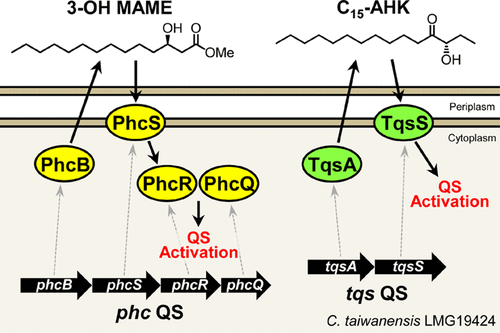当前位置:
X-MOL 学术
›
J. Nat. Prod.
›
论文详情
Our official English website, www.x-mol.net, welcomes your feedback! (Note: you will need to create a separate account there.)
A Unique Combination of Two Different Quorum Sensing Systems in the β-Rhizobium Cupriavidus taiwanensis.
Journal of Natural Products ( IF 5.1 ) Pub Date : 2020-06-02 , DOI: 10.1021/acs.jnatprod.0c00054 Takayuki Wakimoto 1 , Shiori Nakagishi 1 , Nao Matsukawa 1 , Shuji Tani 1 , Kenji Kai 1
Journal of Natural Products ( IF 5.1 ) Pub Date : 2020-06-02 , DOI: 10.1021/acs.jnatprod.0c00054 Takayuki Wakimoto 1 , Shiori Nakagishi 1 , Nao Matsukawa 1 , Shuji Tani 1 , Kenji Kai 1
Affiliation

|
Cupriavidus taiwanensis LMG19424, a β-rhizobial symbiont of Mimosa pudica, harbors phc and tqs quorum sensing (QS), which are the homologous cell–cell communication systems previously identified from the plant pathogen Ralstonia solanacearum and the human pathogen Vibrio cholerae, respectively. However, there has been no experimental evidence reported that these QS systems function in C. taiwanensis LMG19424. We identified (R)-methyl 3-hydroxymyristate (3-OH MAME) and (S)-3-hydroxypentadecan-4-one (C15-AHK) as phc and tqs QS signals, respectively, and characterized these QS systems. The expression of the signal synthase gene phcB and tqsA in E. coli BL21(DE3) resulted in the high production of 3-OH MAME and C15-AHK, respectively. Their structures were elucidated by comparison of EI-MS data and GC/chiral LC retention times with synthetic standards. The deletion of phcB reduced cell motility and increased biofilm formation, and the double deletion of phcB/tqsA caused the accumulation of the metal chelator coproporphyrin III in its mutant culture. Although the deletion of phcB and tqsA slightly reduced its ability to nodulate on aseptically grown seedlings of M. pudica, there was no significant difference in nodule formation between LMG19424 and its QS mutants when commercial soils were used. Taken together, this is the first example of the simultaneous production of 3-OH MAME/C15-AHK as QS signals in a bacterial species, and the importance of the phc/tqs QS systems in the saprophytic stage of C. taiwanensis LMG19424 is suggested.
中文翻译:

β-Rhizobium Cupriavidus taiwanensis 中两种不同群体感应系统的独特组合。
Cupriavidus taiwanensis LMG19424 是含羞草的 β-根瘤菌共生体,具有phc和tqs群体感应 (QS),它们是先前分别从植物病原体青枯病菌和人类病原体霍乱弧菌中鉴定的同源细胞-细胞通讯系统。然而,没有实验证据报告这些 QS 系统在C. taiwanensis LMG19424 中起作用。我们将 ( R ) -3-羟基肉豆蔻酸甲酯(3-OH MAME) 和 ( S )-3-羟基十五烷-4-one (C 15 -AHK)鉴定为phc和tqsQS 信号,并表征这些 QS 系统。信号合酶基因phcB和tqsA在大肠杆菌BL21(DE3) 中的表达分别导致3-OH MAME 和C 15 -AHK的高产量。通过将 EI-MS 数据和 GC/手性 LC 保留时间与合成标准品进行比较,阐明了它们的结构。phcB的缺失降低了细胞运动性并增加了生物膜的形成,而phcB / tqsA的双重缺失导致了金属螯合剂粪卟啉 III 在其突变培养物中的积累。虽然phcB和tqsA的缺失略微降低其在无菌生长的M. pudica幼苗上的根瘤能力,当使用商业土壤时,LMG19424 与其 QS 突变体之间的根瘤形成没有显着差异。总之,这是在细菌物种中同时产生 3-OH MAME/C 15 -AHK 作为 QS 信号的第一个例子,并且phc / tqs QS 系统在C. taiwanensis LMG19424腐生阶段的重要性是建议。
更新日期:2020-06-26
中文翻译:

β-Rhizobium Cupriavidus taiwanensis 中两种不同群体感应系统的独特组合。
Cupriavidus taiwanensis LMG19424 是含羞草的 β-根瘤菌共生体,具有phc和tqs群体感应 (QS),它们是先前分别从植物病原体青枯病菌和人类病原体霍乱弧菌中鉴定的同源细胞-细胞通讯系统。然而,没有实验证据报告这些 QS 系统在C. taiwanensis LMG19424 中起作用。我们将 ( R ) -3-羟基肉豆蔻酸甲酯(3-OH MAME) 和 ( S )-3-羟基十五烷-4-one (C 15 -AHK)鉴定为phc和tqsQS 信号,并表征这些 QS 系统。信号合酶基因phcB和tqsA在大肠杆菌BL21(DE3) 中的表达分别导致3-OH MAME 和C 15 -AHK的高产量。通过将 EI-MS 数据和 GC/手性 LC 保留时间与合成标准品进行比较,阐明了它们的结构。phcB的缺失降低了细胞运动性并增加了生物膜的形成,而phcB / tqsA的双重缺失导致了金属螯合剂粪卟啉 III 在其突变培养物中的积累。虽然phcB和tqsA的缺失略微降低其在无菌生长的M. pudica幼苗上的根瘤能力,当使用商业土壤时,LMG19424 与其 QS 突变体之间的根瘤形成没有显着差异。总之,这是在细菌物种中同时产生 3-OH MAME/C 15 -AHK 作为 QS 信号的第一个例子,并且phc / tqs QS 系统在C. taiwanensis LMG19424腐生阶段的重要性是建议。



























 京公网安备 11010802027423号
京公网安备 11010802027423号